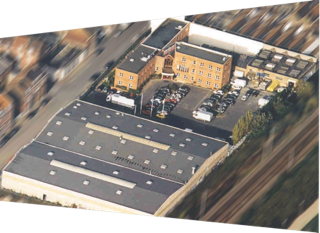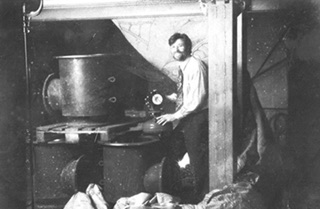OUR HISTORY
AN UNUSUAL IDEA:
THE PRINCIPLE OF THE FLUSH
_________
In 1977, Hervé Simoëns was regularly confronted with the constraints of getting rid of waste in silo or hopper type storage units. At the time, to solve this problem, the inflatable panel was the main solution. Certainly efficient, this principle didn’t however apply to all kinds of materials. Moreover, it led to significant costs in terms of installation and upkeep as well as maintenance difficulties.
The origin of the AIRCHOC® air canon is based on the principle of the flush. The idea was to develop a mechanism located outside of its area of intervention. However, the energy had to be different. In the industry, compressed air is the least harmful energy and is available everywhere, or almost everywhere.

_________
For several months, research and tests were carried out based on this principle by imagining an instantaneous opening system. The concept seemed promising.
Through sheer perseverance, Hervé Simoëns took out his first patent on the AIRCHOC® air canon in 1978 and created STANDARD INDUSTRIE International.
The company base is in the North of France, it started with a market research approach in this region. The first customers to place their trust in it were:
– USINOR (now ARCELOR)
– SURCHISTE, from the Coal Mines of Nord-Pas de Calais
– LAFARGE cements in Haubourdin
– VALRHONA
Very quickly, these recommendations attracted other customers from similar groups and industries.
In 1981, STANDARD INDUSTRIE International was crossing borders. Up until then it was only managing requests from France. It then put its know-how to use with LAFARGE Cements in MEKNES (Morocco)
THE RISE OF STANDARD INDUSTRIE INTERNATIONAL

Strengthened by his budding expertise and knowledge of the market, Hervé Simoëns therefore decided to set up branches in Europe: Spain, Italy, Belgium, the UK and Germany.
From the 90s, its development spread to Mexico, South Africa, Canada, the USA, China and South East Asia. Then in 2009, a liaison office was opened in Singapore and in 2013, the American branch opened its new 2,500m2 premises.
In order to establish STANDARD INDUSTRIE International’s presence over all the territories, an export sales network, strengthened by the presence of representatives, was deployed.
Now, no less than 7 sales teams and 50 representatives are dedicated to the Eastern countries, South East Asia, Maghreb, the Middle East and Sub-Saharan Africa.
DIVERSIFIED SOLUTIONS AT THE SERVICE OF BULK MATERIAL INDUSTRIES
In addition to its geographical development, STANDARD INDUSTRIE International diversified its range of solutions:
– The AIRCHOC® air canon evolved: different configurations, tank capacities adapted to the needs of each customer, applications extended to numerous industries, etc.
The range of STANDARD INDUSTRIE International air canons, designed to respond to clogging and concretion problems, is now the largest on the market.
– In the early 90s, STANDARD INDUSTRIE International developed equipment designed to carry out silo and hopper cleaning services. It was then that the POWERNET and GIRONET went into forming the STANDARD INDUSTRIE International “silo and hopper cleaning services” range.
– From 1995, STANDARD INDUSTRIE International had been supplying mobile vacuum cleaner machines for a regional manufacturer, nationally renowned for the quality of their material. 4 years later, Hervé Simoëns bought the manufacturer. Having taken on this knowledge, STANDARD INDUSTRIE International enlarged its business with the “Industrial Vacuum Cleaning” range.
– In 2005, Hervé Simoëns decided to enrich STANDARD INDUSTRIE International’s business by acquiring a patent for the optimisation of traditional conveyors belts. He sold this solution under the name LIFTUBE® and, over the years, developed it with several versions.
Since 1978, STANDARD INDUSTRIE International has therefore been specialising and diversifying in the design and manufacturing of equipment. Its aim: to facilitate the conveying of bulk material and powder products safely while respecting the environment.
Thanks to its procedures, no less than 60 industries are optimising the performance of their production tools, all the while reducing their operating and maintenance costs.
_________